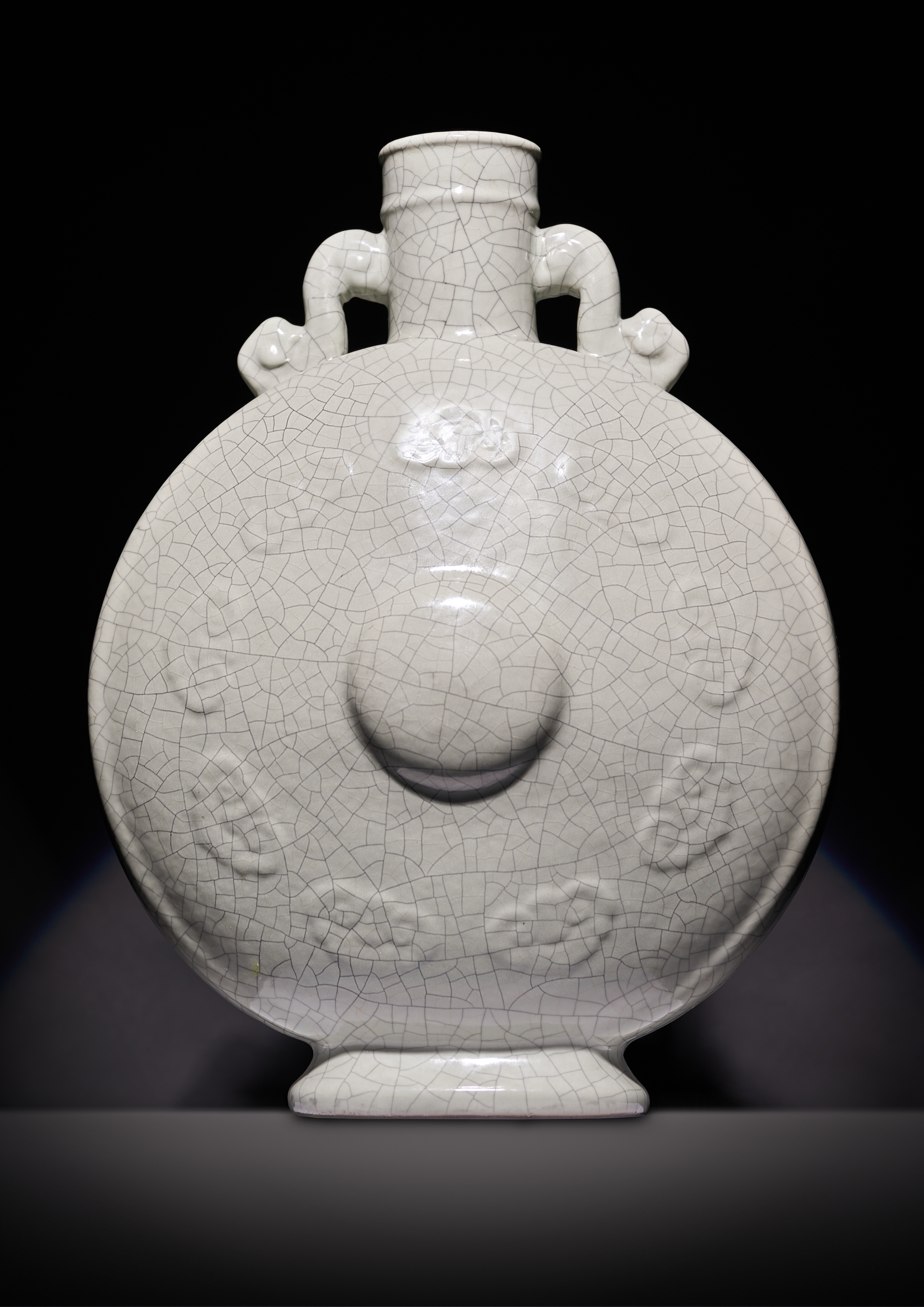Fine Chinese Paintings & Works of Art - 7th December 2020
Lot 121
A RARE AND MASSIVE CHINESE GE-TYPE MOONFLASK
Estimate £10,000 - £20,000 | Hammer £28000
+ Buyers Premium
Description

A RARE AND MASSIVE CHINESE GE-TYPE MOONFLASK, BAOYUEPING
YONGZHENG 1723-35
The flattened body moulded to each side with a large circular central boss surrounded by nine ruyi-heads, decorated all over with a pale greenish-grey glaze suffused with dark crackles, the short cylindrical neck flanked by two applied scroll handles, all raised on a short gently flared foot, 50cm.
Provenance: from the estate of Dikran Ouzounian (d.8th November 2011) and Seta Ouzounian (deceased), 79 Cadogan Square, London, and thence by descent.
The glaze on this imposing moonflask is an active tribute to earlier Chinese Ge wares, which were notable for their deliberate irregular crackle. Whilst the exact location of the site remains unknown, the Ge kiln is regarded as one of the Five Great Kilns (Wu Da Ming Yao) of the Song dynasty, along with Ru, Jun, Guan and Ding wares. It is, however, interesting to note that no examples of Ge pieces have been discovered in Song dynasty tombs, and so their dating is still contentious amongst modern scholars. It is in fact possible that Ge pieces were not produced until the Yuan dynasty, perhaps as a copy of Song Imperial Guan wares.
Imitations of Ge glazes applied to porcelain bodies first appeared during the Ming dynasty, and Imperial pieces of this type were produced during the reigns of the Xuande (r.1426-35) and Chenghua (r.1465-1487) Emperors. The later Ming saw the creation of only a few exceptional pieces of this type, and it was not until the reign of the Qing dynasty emperor Yongzheng (r.1723-35) that the imitation of Ge pieces was reinvigorated and reached new levels of sophistication.
The Yongzheng Emperor is known to have been fascinated with the past and is remembered as a passionate collector of antiques. Under such a keen patron with great enthusiasm for works of art made for the Imperial Court, the potters at the Imperial Kilns in Jingdezhen carried out much research and experimentation during this period. The workers developed an extensive range of fine monochromes including reinventions of early wares, which reflected the Yongzheng Emperor's admiration of antiquity. Tang Ying (1682-1756), one of the most renowned supervisors of the Imperial Kilns, is particularly associated with the production of pieces imitating early wares during this period, and he writes about the production of imitation Ru, Guan and Ge wares in his Records of Ceramic Production (Taocheng jishi).
For a more in-depth discussion on Yongzheng period copies of earlier Chinese wares, see Wang Qingzheng, Yongzheng Imitations of Guan, Ge, Ru and Jun Wares, Chinese Ceramics: Selected Articles from Orientations 1982-1998, pp.265-270.
Cf. Bonhams Hong Kong, 26th May 2007, lot 220 for a similar vase; see also Sotheby's London, 8th November 2006, lot 173 for a comparable piece moulded with the Eight Trigrams; see also Sotheby's Hong Kong, 28th November 1978, lot 207 for a related Guan-type moonflask with the Eight Trigrams design.